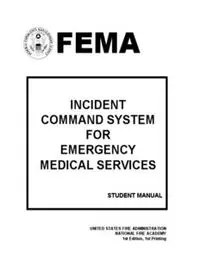
Incident Command System for Emergency Medical Services--Student Manual PDF
Preview Incident Command System for Emergency Medical Services--Student Manual
FEMA INCIDENT COMMAND SYSTEM FOR EMERGENCY MEDICAL SERVICES STUDENT MANUAL UNITED STATES FIRE ADMINISTRATION NATIONAL FIRE ACADEMY 1st Edition, 1st Printing FEMA/USFA/NFA •INCIDENT COMMAND SYSTEM FOR ICS for EMS-SM January 1999 •EMERGENCY MEDICAL SERVICES FEMA INCIDENT COMMAND SYSTEM FOR EMERGENCY MEDICAL SERVICES STUDENT MANUAL UNITED STATES FIRE ADMINISTRATION NATIONAL FIRE ACADEMY January 1999 INCIDENT COMMAND SYSTEM FOR EMERGENCY MEDICAL SERVICES NOTICE: This material has been developed by the National Fire Academy (NFA) of the United States Fire Administration (USFA) for use by State and metropolitan fire training programs. NFA endorsement of this material is conditional on use without modification. NFA material, whether printed text or software, may not be used in any manner that would mislead or that would suggest or imply endorsement by NFA of any commercial product, process, or service. ii INCIDENT COMMAND SYSTEM FOR EMERGENCY MEDICAL SERVICES FEDERAL EMERGENCY MANAGEMENT AGENCY UNITED STATES FIRE ADMINISTRATION NATIONAL FIRE ACADEMY FOREWORD The Federal Emergency Management Agency (FEMA) was established in 1979. FEMA's mission is to focus Federal effort on preparedness for, mitigation of, response to, and recovery from emergencies encompassing the full range of natural and manmade disasters. FEMA's National Emergency Training Center (NETC) in Emmitsburg, Maryland, includes the United States Fire Administration (USFA), its National Fire Academy (NFA), and the Emergency Management Institute (EMI). To achieve the USFA's legislated mandate (under Public Law 93-498, October 29, 1974), "to advance the professional development of fire service personnel and of other persons engaged in fire prevention and control activities," the U.S. Fire Administration has developed an effective program linkage with established fire training systems which exist at the State and local levels. It is the responsibility of the USFA to support and strengthen these delivery systems. The field courses of the USFA's National Fire Academy have been sponsored by the respective State fire training systems in every State. The USFA's National Fire Academy is proud to join with State and local fire agencies in providing educational opportunities to the members of the Nation's fire services. iii INCIDENT COMMAND SYSTEM FOR EMERGENCY MEDICAL SERVICES iv INCIDENT COMMAND SYSTEM FOR EMERGENCY MEDICAL SERVICES TABLE OF CONTENTS PAGE Foreword . i Table of Contents . v Course Objectives. vi Activity Objectives. vi Course Schedule . ix UNIT 1: INTRODUCTION AND OVERVIEW ................................................ SM 1-1 UNIT 2: INCIDENT COMMAND RESPONSIBILITIES................................ SM 2-1 UNIT 3: ESTABLISHING THE COMMAND ORGANIZATION.................. SM 3-1 UNIT 4: COMMAND AND COMMUNICATIONS OVERVIEW .................. SM 4-1 UNIT 5: THE INITIAL RESPONSE/BASIC ORGANIZATION.................... SM 5-1 UNIT 6: THE COMMAND TOOLBOX ............................................................ SM 6-1 UNIT 7: THE EXPANDED ORGANIZATION/REINFORCED RESPONSE............................................................................................ SM 7-1 UNIT 8: ESCALATED ORGANIZATION--BRANCH AND SECTION OVERVIEW .......................................................................................... SM 8-1 UNIT 9: INCIDENT DEMOBILIZATION AND TERMINATION................ SM 9-1 v INCIDENT COMMAND SYSTEM FOR EMERGENCY MEDICAL SERVICES vi INCIDENT COMMAND SYSTEM FOR EMERGENCY MEDICAL SERVICES COURSE OBJECTIVES The students will: 1. Identify the need for an organized approach to management of emergency medical incidents. 2. Describe the Incident Command System (ICS) and its major components. 3. Describe the responsibilities and functions of the Incident Commander (IC) at all EMS incidents. 4. Describe the communication order model and its purpose. 5. Describe responsibilities and functions of division/group supervisor and other command team members. 6. Describe the transfer-of-command process. 7. Describe responsibilities and functions of branch directors. 8. Describe the responsibilities of the four section chiefs. 9. Describe the purpose and use of progress reporting. 10. Design a command organization for a mass casualty incident (MCI) multi-agency emergency response. 11. Demonstrate competencies required to operate within an ICS structure at any type of emergency incident or training evolution. 12. Describe the communications system necessary for an effective ICS structure. 13. Describe the interpersonal skills required to be an effective command officer. 14. Describe the safety strategies of ICS. 15. Describe the steps required for the ICS demobilization process. ACTIVITY OBJECTIVES The students will: 1. Given a scenario, and working in small groups, prepare a list of concerns about incident and resource management. 2. Given a precourse self-learning package, and working individually, complete a multiple-choice test. 3. Given a command function, and working in small groups, identify the responsibilities and procedures appropriate for the position. 4. Given a simulated community resource description, a written EMS scenario, and working individually, develop an organizational chart for incident management. vii INCIDENT COMMAND SYSTEM FOR EMERGENCY MEDICAL SERVICES 5. Given an audiotaped EMS incident, and working in small groups, prepare a list of concerns about the radio communications. 6. Given a videotaped EMS incident, analyze the incident depicted on the tape for organization, communications, and use of resources. 7. Given an audiotaped EMS incident and sample tactical worksheets, and working in small groups, profile the resources responding to the incident. 8. Given a simulated community resource description and an expanded, written EMS incident scenario, and working in small groups, prepare organizational charts, resource lists, and a description of problems. 9. Given a simulated community resource description and an escalated written EMS incident scenario, and working in small groups, prepare organizational charts, resource lists, and a description of potential problems. 10. Given a simulated community resource description and an escalated written EMS incident scenario, and working in small groups, develop a demobilization plan. 11. Given an ICS unit designation, and working in small groups, correctly identify at least three key factors affecting that sector. viii
